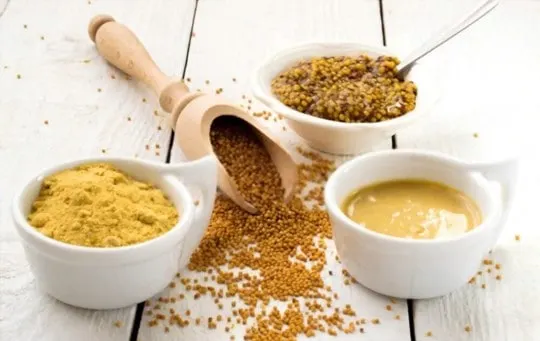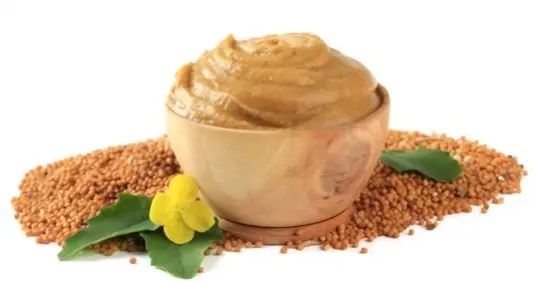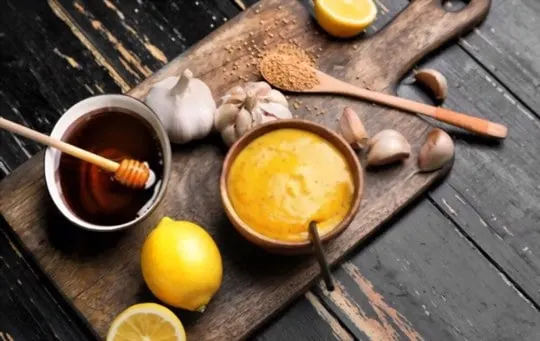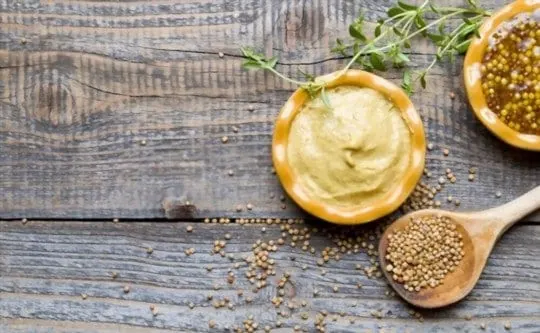Mustard is a type of condiment that is made from the seeds of mustard plants.
The taste and flavor vary widely depending on your use, but most have a robust and tangy flavor.
But what does mustard taste like? There are many different kinds of mustard out there, so it can be challenging to answer this question.
We’ll go over the types of mustards first, and then we will talk about how you can use them in cooking or as a dipping sauce for your favorite foods.
What is Mustard?

Mustard is a condiment that can be found in most American households.
Manufactured mustard and the process of making it are not new.
Still, modern Americans have grown accustomed to a sweetened version with added sugar or honey added for flavor.
Many mustards exist on today’s shelves, including whole-grain varieties and spicy versions, which make them versatile to be used with different dishes.
Mustard is made by grinding mustard seeds until the seed coatings are broken, and a paste-like substance remains, much like making peanut butter from peanuts or garlic powder from garlic cloves.
The ground mixture of mustard seeds can then be mixed with water to produce an acidic liquid similar in consistency to buttermilk.
From this liquid, the ground seeds can be separated and combined with various ingredients to create different types of mustard.
The most common type is prepared mustard, typically consisting of three parts dry mustard powder mixed with one part water or vinegar and salt for seasoning.
Mustard gets its distinctive flavor from an oily-seeded plant called Sinapis Alba (a member of the Cruciferae family).
Many varieties have been cultivated throughout history for their unique flavors and uses.
Still, yellow mustards like deli mustard are made from whole-grain brown or black mustard seeds and distilled white wine.
Mustard seeds grow on every continent except Antarctica, making them readily available in almost all countries worldwide.
Varieties of Mustard

There’s a lot to say about mustard.
Some people are all into spicy mustards, while others prefer milder flavors.
There is also an infinite variety of flavor profiles you can get with your standard yellow and brown mustard.
Here are the top 5 common varieties of mustard.
- Yellow Mustard: Your standard, classic yellow mustard. It’s got a bit more bite than brown mustards and is perfect for your average sandwich or hot dog (or if you’re feeling spicy, use it to make some killer buffalo chicken wings.).
- Spicy Brown Mustard: A little spicier than its lighter counterpart but not as much kick as the other varieties on this list. This type of mustard has a lot going for it when used in sandwiches because all that spice will just slowly melt into whatever else you put inside your sammie. .
- Dijon Mustard: This one is slightly more costly than the others but considers this an investment. Dijon mustard is great on french fries, grilled cheese sandwiches, and just about any other type of sandwich that you prefer to have with a tangy kick.
- Honey Mustard: A lot heavier than most mustards because it is honey mixed in there along with all those yummy spices and vinegar goodness from the yellow mustard base (which means it’s also got a touch less bite). This one works best when you’re looking for something sweet to balance out your meal or if you want some dipping sauce for your chicken strips.
- Whole Grain Mustard: If spice isn’t your thing, we recommend going whole-grain instead of choosing whole grain over brown or yellow. Why? Well, it’s not as spicy, and because it’s more coarse in texture, the flavor will linger on your tongue longer than other mustards, which can make for a more fulfilling sandwich experience.
Depending on the kind of mustard you’re using, the variations in flavor and texture can make all the difference.
Health and Nutritional Benefits of Mustard

Mustard is the perfect condiment for your next barbecue.
Not only does it add a little spice to any dish, but it also has many health benefits.
Mustard seeds are full of antioxidants and have been proven effective in reducing inflammatory responses, such as arthritis or other joint pain.
Mustard seeds also possess a significant amount of Vitamin C, B-complex vitamins, and minerals, including calcium, iron, and zinc.
Mustard seed products such as whole mustard powder or mustard flour have proven to be an excellent dietary fiber source and can help reduce the risk for heart disease, obesity, and diabetes.
The flavor in mustards is derived from the volatile oil content present in its seeds which has been found to contain compounds that act as powerful anti-inflammatory agents with antibiotic properties while also being antimicrobial against some food-borne pathogens like Listeria monocytogenes (source).
Moreover, recent research studies show that consuming high levels of raw cruciferous vegetables may lower your risk for cancer by reducing DNA damage caused by compounds known as carcinogens.
Some studies have also shown that mustard seed may lower your risk for developing cancer of the stomach and breast by reducing cell proliferation, decreasing tumor size, and inhibiting metastases (source).
Finally, research has found that consuming high levels of raw cruciferous vegetables every day can help to prevent sunburns in one’s skin because they contain substances called glucosinolates which are potent antioxidants.
What Does Mustard Smell Like?

Imagine it for a second, mustard.
It’s the perfect food to spice up any sandwich or burger and an excellent condiment on fries too.
When you smell your favorite jar of yellow gold, do you notice anything about its aroma?
You might be surprised to learn that it’s not just a single odor.
You can detect several distinct aromas and flavors when sniffing this popular condiment:
- Spicy, sweet, fruity-fruitiness (apple).
- Earthy notes of smoke.
- Burnt sugar cane sweetness combined with vinegar created by the fermentation process.
What Does Mustard Taste Like?

Mustards vary in taste, even among different brands.
You can’t say that there is one distinct taste for all mustards because they are so different in flavor, but they all share a common trait: the solid tangy, and piquant flavors.
It’s hard to sum up, what mustard tastes like with words because it varies depending on how you use it and where you live (due to regional preferences).
Some people describe the taste of prepared yellow mustard as more “vinegary,” while others find them sweeter than brown or dijon types.
Mustard usually has a horseradish-like bite from its ingredients, such as turmeric, which gives it an earthiness and slight warmth.
It also tends to have some sweetness coming from things like honey or sugar cane.
What Does Yellow Mustard Taste Like?

The moment you grab a yellow mustard jar, your astute senses start to smell the tangy and spicy aroma escaping from its confines.
It invades your nostrils with such intensity that it smells refreshingly like an ocean breeze in the summertime for no matter how hot outside is.
The bright, yellow color of yellow mustard comes from turmeric.
Yellow mustard seeds are combined with vinegar and water to make a vicious, squeezable sauce.
It has an acidic flavor that is more tart than spicy.
Yellow mustard is most commonly used as a condiment on hot dogs, with the average American eating over three pounds of it annually.
Not just for snacking either, yellow mustard can also be an ingredient in many recipes like deviled eggs and South African bunny chow.
What Does Spicy Brown Mustard Taste Like?

There are many things that people can use to describe the taste of spicy brown mustard, but most say it tastes like a delicious blend of horseradish and garlic.
It might sound strange at first, especially when you don’t know what ingredients are in it, but give this mustard a try, and you may be pleasantly surprised.
The color of spicy brown mustard will vary depending on how much vinegar was added during preparation, ranging anywhere from light yellow to bright orangey-red – sometimes even appearing pinkish due to beetroot containing nitrates (this generally only happens with homemade spiced mustards).
For most brands manufactured by widespread companies like French’s, this mustard falls typically on the darker side of the color spectrum.
It is intended to have a more intense and rich flavor.
Mildly spicy brown mustard is used in Indian, Chinese, and Japanese cooking.
It’s from the same family as arugula, horseradish, and wasabi, so it has a strong, pungent flavor.
What Does Honey Mustard Taste Like?

Honey mustard has been around since at least 1881, when it was first created to replace honey that had crystallized after being shipped from France to New York City.
There are many different variations of this sauce, but generally, there’s always vinegar or some other acidic component, a sweetener, and dry mustard.
Honey Mustard’s taste profile:
- The sweetness from the honey lends it an almost syrupy quality that is often mellowed out with apple cider vinegar or rice wine vinegar.
- Dry mustard adds spice to the sauce, but its flavor is less intense than whole-grain mustard because of how finely ground it typically is.
- Mustard seeds are optional in most recipes, but where they’re found, they usually give honey mustard a deeper taste, thanks to their oils. This variation can be made by adding yellow mustard seed (or black) and white flour and water for half an hour before combining them with other ingredients.
- Garlic and onion are commonly used, too. They both add a savory flavor to the dish that can go from sweet to sharp depending on how much is included in any given recipe.
What Does Whole Grain Mustard Taste Like?

Whole grain mustard is made from the ground seeds of white and brown varieties.
The flavor of whole-grain mustard varies depending on which type is used to make it, but its tangy and spicy taste will always be present.
Its color can range from yellow-orange to brown because of the turmeric or other natural preservatives that are in it.
This spice has a strong taste with notes of earthiness or spiciness mixed.
The intensity depends on what kind was chosen for preparation – some types have more kick than others, but they all share this characteristic punch flavor.
What Does Dijon Mustard Taste Like?

Have you ever tried Dijon-style mustard before, or are your tastes more traditional and straightforward, like whole-grain or yellow mustards? There is a wide range of flavors, from sweet to tangy.
The most popular type of Dijon-style mustard is French’s Mustard because it has been around for over 100 years.
In France, where it originated, Dijon tastes sharp with solid garlic and white wine mixed into its creamy texture.
It has become widespread for flavoring dishes and sauces with a little bit of mustard.
You can find Dijon-style mustards in the French dressing aisle as well, which are perfect to use on salads or even with some sliced turkey sandwiches.
The flavor is milder than what you would expect from traditional yellow or whole-grain mustard but still packs a punch when it comes to tangy taste.
Most people who try this style of mustard for the first time like how sharp and tangy it tastes because the white wine provides an added depth that regular mayonnaise does not have.
How to Use Mustard in Recipes?

The history of mustard has been around for centuries.
It is believed that the Romans introduced this spicy condiment to northern Europe, while other ancient civilizations like India and China used it as a medicine or food preservative.
Today, you can find mustards in different flavor profiles, such as honey with whole-grain bread or even soy sauce combined with sesame seeds.
Now that we have covered the basics about mustard’s background, let us dive into how it should be incorporated into your recipes.
Mustard pairs well with fish dishes because they are tangy sauces; however, if you want an extra punch, throw some curry powder in there.
You can also use sour cream mixed with Dijon mustard in creamy coleslaw salad dressings.
Try a side of honey mustard chicken for your next BBQ feast.
It is perfect for glazes and sauces because it will not break down the meat as some other salad dressings might do.
Since we are on the topic of salads, you can also try using mustard over leafy greens with vinegar or lemon juice to make an exciting vinaigrette that adds flavor but does not overwhelm the dish’s natural flavors.
Whole grain mustard with honey is also an excellent combo for bratwurst.
How to Store Mustard?

If you’re not using it often, a refrigerator is great for storing fresh jars.
You should keep it in its original jar and put an air-tight lid that can be screwed shut over the top of it like this.
Mustard keeps well at room temperature if kept sealed tightly in a calm environment as long as condiments are not exposed to light or heat.
The fridge may seem counterintuitive, but since mustards rely so heavily on vinegar (which also degrades when exposed to sunlight), then storing them there will extend their shelf life significantly longer than it would be.
Keep a cool, dark place on your counter for storing opened jars until successive use.
Conclusion
Mustard is a condiment that can be purchased in most grocery stores.
There are many different types of mustard with varying levels of spiciness and color, but the taste will vary depending on what you put it on.
You may find that even if you don’t like the flavor of yellow mustard at first, there is one out there for you.
If you’ve never tried mustard out for yourself before, we recommend giving some varieties a try.
Let us know which one was your favorite in the comments below.

What Does Mustard Taste Like? Does Mustard Taste Good?
Ingredients
- Mustard
- Ingredients from your favorite recipes
Instructions
- Depending on the recipes you choose, the taste can vastly differ.
- For authentic results, it is important to choose a recipe that will highlight the original flavor.
- Have fun experimenting with different recipes and taste tests!
